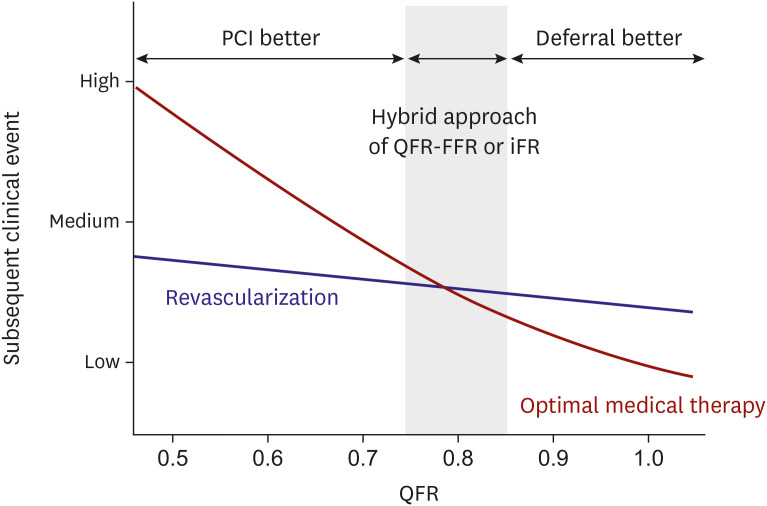Korean Circ J.
2021 Feb;51(2):140-142. 10.4070/kcj.2020.0511.
Would a Noninvasive Coronary Physiology Become a Standard and Popular Approach?
- Affiliations
-
- 1Department of Cardiology, Keimyung University Dongsan Hospital, Daegu, Korea
- KMID: 2512451
- DOI: http://doi.org/10.4070/kcj.2020.0511
Figure
Reference
-
1. Cho YK, Nam CW, Han JK, et al. Usefulness of combined intravascular ultrasound parameters to predict functional significance of coronary artery stenosis and determinants of mismatch. EuroIntervention. 2015; 11:163–170. PMID: 26093837.
Article2. Nam CW, Yoon HJ, Cho YK, et al. Outcomes of percutaneous coronary intervention in intermediate coronary artery disease: fractional flow reserve-guided versus intravascular ultrasound-guided. JACC Cardiovasc Interv. 2010; 3:812–817. PMID: 20723852.3. Cho YK, Nam CW. Percutaneous coronary intervention in patients with multi-vessel coronary artery disease: a focus on physiology. Korean J Intern Med. 2018; 33:851–859. PMID: 29551050.
Article4. Lee JM, Choi KH, Doh JH, et al. Long-term patient prognostication by coronary flow reserve and index of microcirculatory resistance: international registry of comprehensive physiologic assessment. Korean Circ J. 2020; 50:890–903. PMID: 32725991.
Article5. Kim JH, Choi W, Kim KC, et al. The current status of intervention for intermediate coronary stenosis in the Korean Percutaneous Coronary Intervention (K-PCI) Registry. Korean Circ J. 2019; 49:1022–1032. PMID: 31190480.
Article6. Götberg M, Christiansen EH, Gudmundsdottir IJ, et al. Instantaneous wave-free ratio versus fractional flow reserve to guide PCI. N Engl J Med. 2017; 376:1813–1823. PMID: 28317438.7. Tu S, Westra J, Yang J, et al. Diagnostic accuracy of fast computational approaches to derive fractional flow reserve from diagnostic coronary angiography: the International Multicenter FAVOR Pilot Study. JACC Cardiovasc Interv. 2016; 9:2024–2035. PMID: 27712739.8. Xu B, Tu S, Qiao S, et al. Diagnostic accuracy of angiography-based quantitative flow ratio measurements for online assessment of coronary stenosis. J Am Coll Cardiol. 2017; 70:3077–3087. PMID: 29101020.9. Hwang D, Jeon KH, Lee JM, et al. Diagnostic performance of resting and hyperemic invasive physiological indices to define myocardial ischemia: validation with 13N-ammonia positron emission tomography. JACC Cardiovasc Interv. 2017; 10:751–760. PMID: 28365268.
- Full Text Links
- Actions
-
Cited
- CITED
-
- Close
- Share
- Similar articles
-
- Coronary Physiology-Based Approaches for Plaque Vulnerability: Implications for Risk Prediction and Treatment Strategies
- Understanding the Coronary Bifurcation Stenting
- Overlooked or unrecognized pitfalls in noninvasive multi-detector computed tomography coronary angiography
- Technical Aspect of Coronary CT Angiography: Imaging Tips and Safety Issues
- Comparison of the Diagnostic Power of Computed Tomography Coronary Angiography and Exercise Electrocardiography as a First Screening Test in Real-World Practice: Is It Ready for Clinical Use?


